Research Literature Analysis: Cloud Computing Security in Business
VerifiedAdded on 2022/10/10
|10
|2439
|20
Report
AI Summary
This report presents a literature analysis on the security issues in cloud computing. It begins with an introduction to cloud computing and its advancements, highlighting the benefits such as scalability and data handling efficiency, while also pinpointing the primary concern: information security. The problem statement focuses on the challenges of securing data and protecting privacy within cloud environments, emphasizing the paradox of cloud computing's advanced technology and its inherent security vulnerabilities. The research methodology identifies the research as qualitative, relying on secondary data analysis of existing literature. The approach involves comparing and contrasting different research papers on cloud computing and security to identify shortcomings and advantages. The scope of the analysis centers on peer-reviewed papers addressing cloud infrastructure security, including deployment models like private, public, and hybrid clouds, and service models such as IaaS, PaaS, and SaaS. The literature analysis explores the dependencies within the cloud computing stack that contribute to security issues, the complexities of the system impacting elasticity and scaling, and the inconsistencies in security models. The report concludes by summarizing the key findings, including the identification of research gaps and conflicts in cloud computing security and the need for further research to provide solutions to these problems.
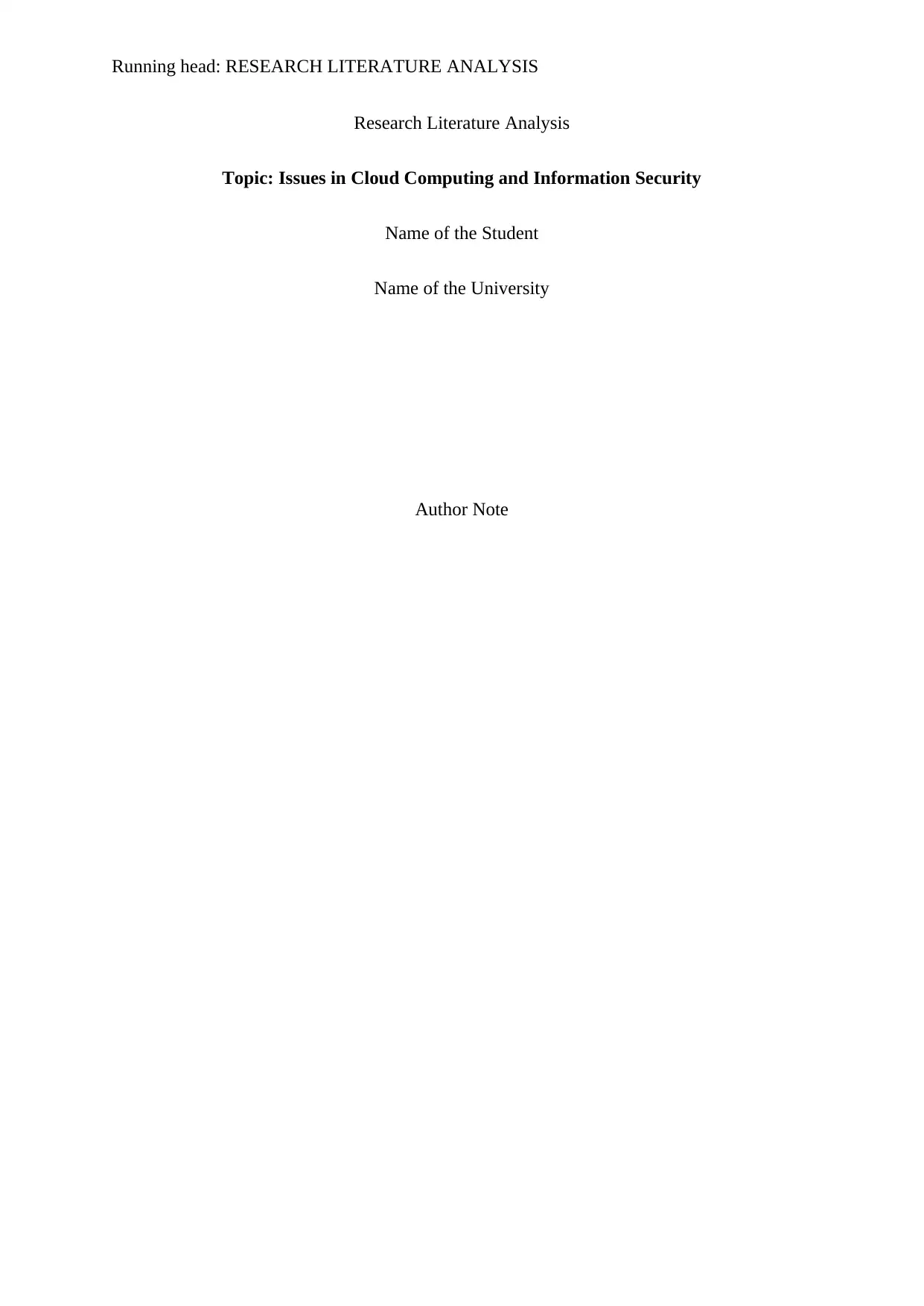
Running head: RESEARCH LITERATURE ANALYSIS
Research Literature Analysis
Topic: Issues in Cloud Computing and Information Security
Name of the Student
Name of the University
Author Note
Research Literature Analysis
Topic: Issues in Cloud Computing and Information Security
Name of the Student
Name of the University
Author Note
Paraphrase This Document
Need a fresh take? Get an instant paraphrase of this document with our AI Paraphraser
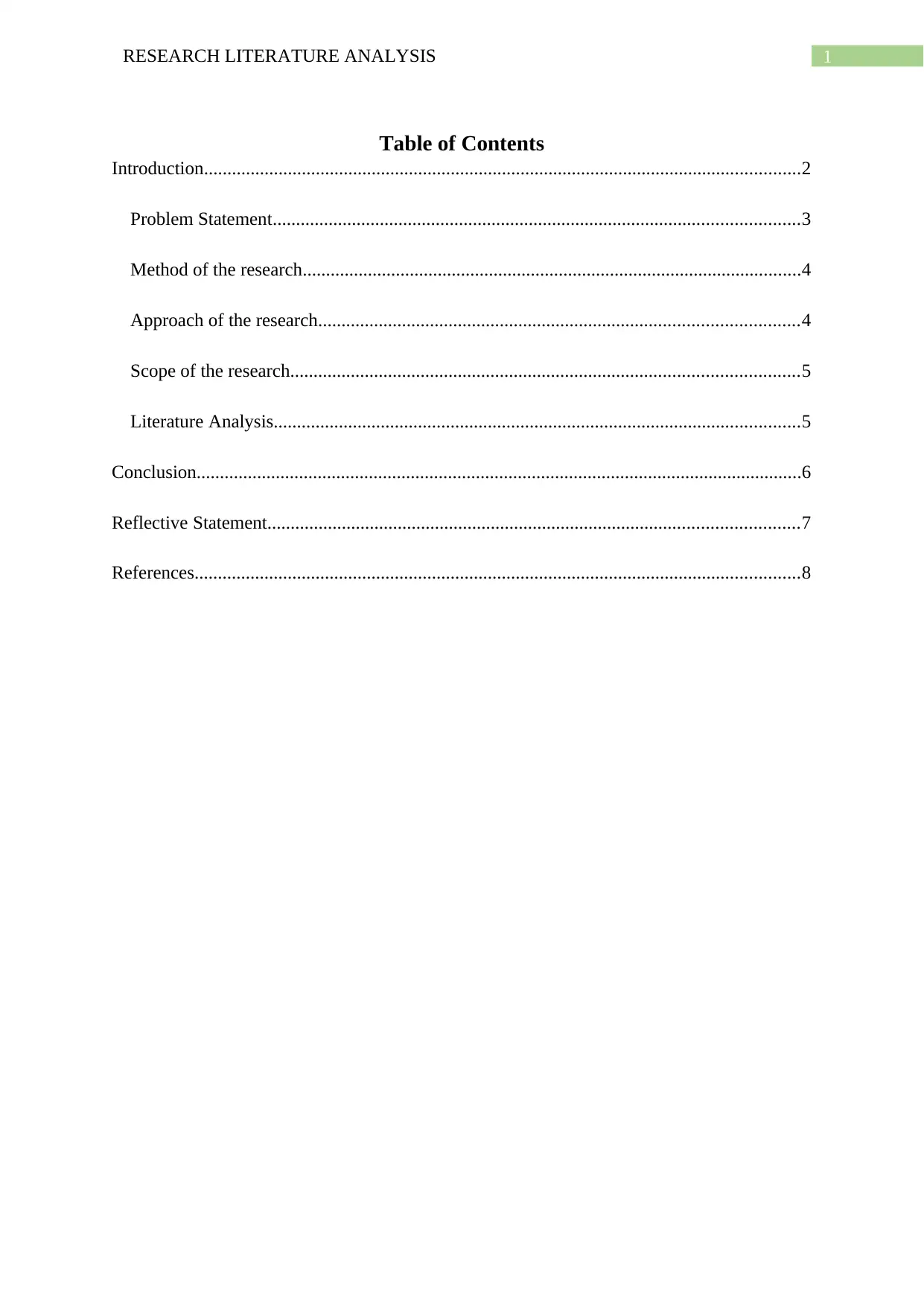
1RESEARCH LITERATURE ANALYSIS
Table of Contents
Introduction................................................................................................................................2
Problem Statement.................................................................................................................3
Method of the research...........................................................................................................4
Approach of the research.......................................................................................................4
Scope of the research.............................................................................................................5
Literature Analysis.................................................................................................................5
Conclusion..................................................................................................................................6
Reflective Statement..................................................................................................................7
References..................................................................................................................................8
Table of Contents
Introduction................................................................................................................................2
Problem Statement.................................................................................................................3
Method of the research...........................................................................................................4
Approach of the research.......................................................................................................4
Scope of the research.............................................................................................................5
Literature Analysis.................................................................................................................5
Conclusion..................................................................................................................................6
Reflective Statement..................................................................................................................7
References..................................................................................................................................8
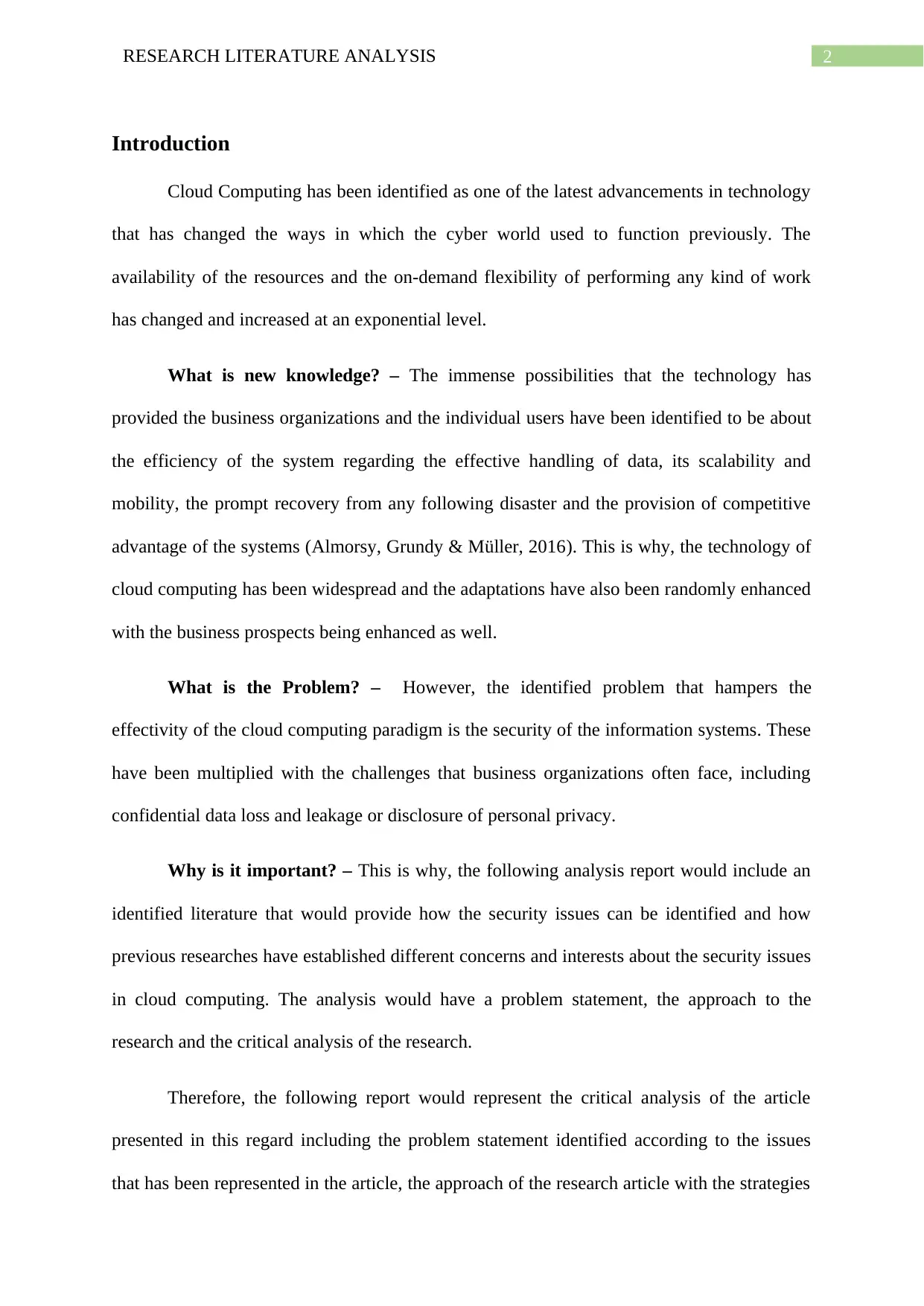
2RESEARCH LITERATURE ANALYSIS
Introduction
Cloud Computing has been identified as one of the latest advancements in technology
that has changed the ways in which the cyber world used to function previously. The
availability of the resources and the on-demand flexibility of performing any kind of work
has changed and increased at an exponential level.
What is new knowledge? – The immense possibilities that the technology has
provided the business organizations and the individual users have been identified to be about
the efficiency of the system regarding the effective handling of data, its scalability and
mobility, the prompt recovery from any following disaster and the provision of competitive
advantage of the systems (Almorsy, Grundy & Müller, 2016). This is why, the technology of
cloud computing has been widespread and the adaptations have also been randomly enhanced
with the business prospects being enhanced as well.
What is the Problem? – However, the identified problem that hampers the
effectivity of the cloud computing paradigm is the security of the information systems. These
have been multiplied with the challenges that business organizations often face, including
confidential data loss and leakage or disclosure of personal privacy.
Why is it important? – This is why, the following analysis report would include an
identified literature that would provide how the security issues can be identified and how
previous researches have established different concerns and interests about the security issues
in cloud computing. The analysis would have a problem statement, the approach to the
research and the critical analysis of the research.
Therefore, the following report would represent the critical analysis of the article
presented in this regard including the problem statement identified according to the issues
that has been represented in the article, the approach of the research article with the strategies
Introduction
Cloud Computing has been identified as one of the latest advancements in technology
that has changed the ways in which the cyber world used to function previously. The
availability of the resources and the on-demand flexibility of performing any kind of work
has changed and increased at an exponential level.
What is new knowledge? – The immense possibilities that the technology has
provided the business organizations and the individual users have been identified to be about
the efficiency of the system regarding the effective handling of data, its scalability and
mobility, the prompt recovery from any following disaster and the provision of competitive
advantage of the systems (Almorsy, Grundy & Müller, 2016). This is why, the technology of
cloud computing has been widespread and the adaptations have also been randomly enhanced
with the business prospects being enhanced as well.
What is the Problem? – However, the identified problem that hampers the
effectivity of the cloud computing paradigm is the security of the information systems. These
have been multiplied with the challenges that business organizations often face, including
confidential data loss and leakage or disclosure of personal privacy.
Why is it important? – This is why, the following analysis report would include an
identified literature that would provide how the security issues can be identified and how
previous researches have established different concerns and interests about the security issues
in cloud computing. The analysis would have a problem statement, the approach to the
research and the critical analysis of the research.
Therefore, the following report would represent the critical analysis of the article
presented in this regard including the problem statement identified according to the issues
that has been represented in the article, the approach of the research article with the strategies
⊘ This is a preview!⊘
Do you want full access?
Subscribe today to unlock all pages.

Trusted by 1+ million students worldwide
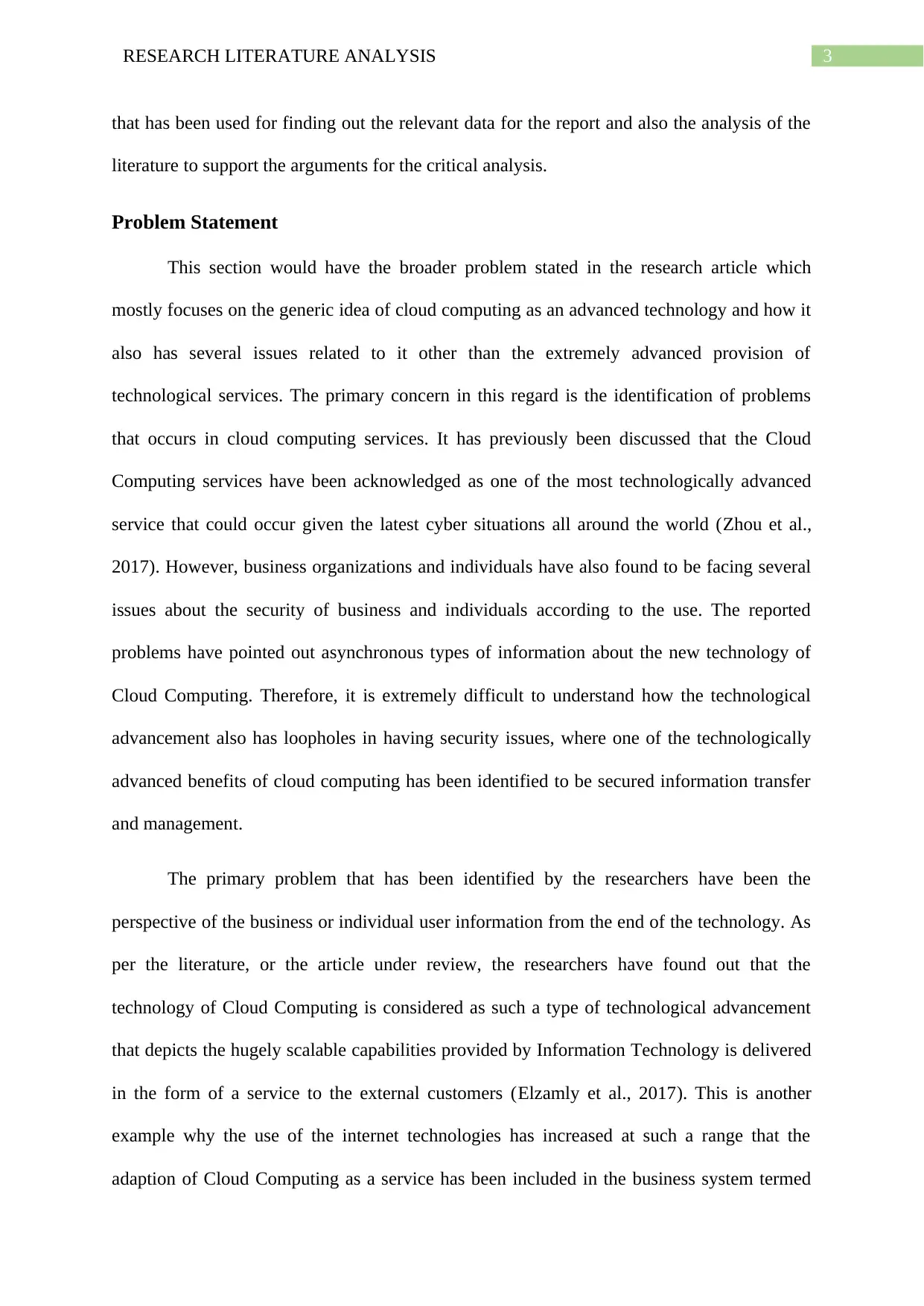
3RESEARCH LITERATURE ANALYSIS
that has been used for finding out the relevant data for the report and also the analysis of the
literature to support the arguments for the critical analysis.
Problem Statement
This section would have the broader problem stated in the research article which
mostly focuses on the generic idea of cloud computing as an advanced technology and how it
also has several issues related to it other than the extremely advanced provision of
technological services. The primary concern in this regard is the identification of problems
that occurs in cloud computing services. It has previously been discussed that the Cloud
Computing services have been acknowledged as one of the most technologically advanced
service that could occur given the latest cyber situations all around the world (Zhou et al.,
2017). However, business organizations and individuals have also found to be facing several
issues about the security of business and individuals according to the use. The reported
problems have pointed out asynchronous types of information about the new technology of
Cloud Computing. Therefore, it is extremely difficult to understand how the technological
advancement also has loopholes in having security issues, where one of the technologically
advanced benefits of cloud computing has been identified to be secured information transfer
and management.
The primary problem that has been identified by the researchers have been the
perspective of the business or individual user information from the end of the technology. As
per the literature, or the article under review, the researchers have found out that the
technology of Cloud Computing is considered as such a type of technological advancement
that depicts the hugely scalable capabilities provided by Information Technology is delivered
in the form of a service to the external customers (Elzamly et al., 2017). This is another
example why the use of the internet technologies has increased at such a range that the
adaption of Cloud Computing as a service has been included in the business system termed
that has been used for finding out the relevant data for the report and also the analysis of the
literature to support the arguments for the critical analysis.
Problem Statement
This section would have the broader problem stated in the research article which
mostly focuses on the generic idea of cloud computing as an advanced technology and how it
also has several issues related to it other than the extremely advanced provision of
technological services. The primary concern in this regard is the identification of problems
that occurs in cloud computing services. It has previously been discussed that the Cloud
Computing services have been acknowledged as one of the most technologically advanced
service that could occur given the latest cyber situations all around the world (Zhou et al.,
2017). However, business organizations and individuals have also found to be facing several
issues about the security of business and individuals according to the use. The reported
problems have pointed out asynchronous types of information about the new technology of
Cloud Computing. Therefore, it is extremely difficult to understand how the technological
advancement also has loopholes in having security issues, where one of the technologically
advanced benefits of cloud computing has been identified to be secured information transfer
and management.
The primary problem that has been identified by the researchers have been the
perspective of the business or individual user information from the end of the technology. As
per the literature, or the article under review, the researchers have found out that the
technology of Cloud Computing is considered as such a type of technological advancement
that depicts the hugely scalable capabilities provided by Information Technology is delivered
in the form of a service to the external customers (Elzamly et al., 2017). This is another
example why the use of the internet technologies has increased at such a range that the
adaption of Cloud Computing as a service has been included in the business system termed
Paraphrase This Document
Need a fresh take? Get an instant paraphrase of this document with our AI Paraphraser
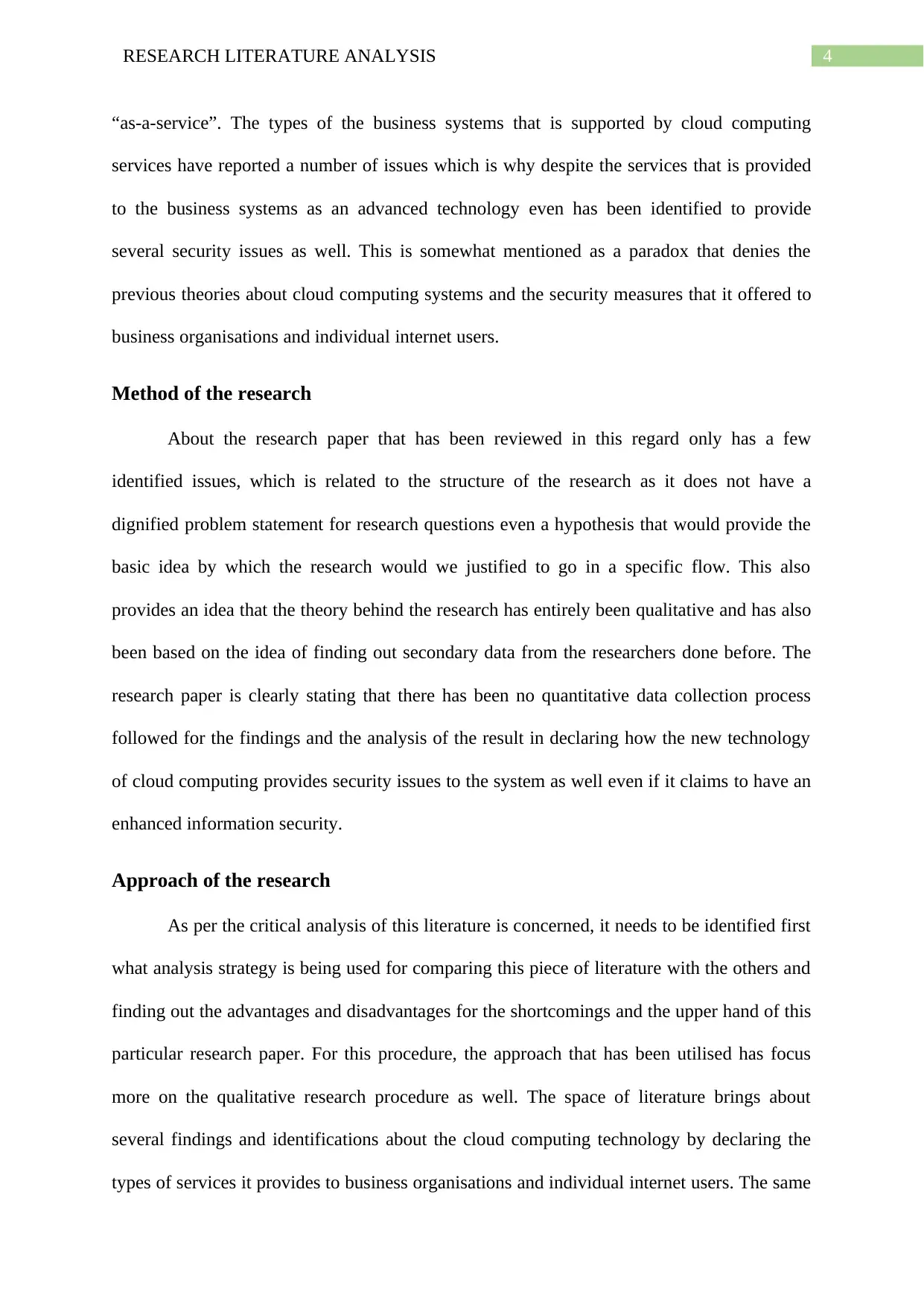
4RESEARCH LITERATURE ANALYSIS
“as-a-service”. The types of the business systems that is supported by cloud computing
services have reported a number of issues which is why despite the services that is provided
to the business systems as an advanced technology even has been identified to provide
several security issues as well. This is somewhat mentioned as a paradox that denies the
previous theories about cloud computing systems and the security measures that it offered to
business organisations and individual internet users.
Method of the research
About the research paper that has been reviewed in this regard only has a few
identified issues, which is related to the structure of the research as it does not have a
dignified problem statement for research questions even a hypothesis that would provide the
basic idea by which the research would we justified to go in a specific flow. This also
provides an idea that the theory behind the research has entirely been qualitative and has also
been based on the idea of finding out secondary data from the researchers done before. The
research paper is clearly stating that there has been no quantitative data collection process
followed for the findings and the analysis of the result in declaring how the new technology
of cloud computing provides security issues to the system as well even if it claims to have an
enhanced information security.
Approach of the research
As per the critical analysis of this literature is concerned, it needs to be identified first
what analysis strategy is being used for comparing this piece of literature with the others and
finding out the advantages and disadvantages for the shortcomings and the upper hand of this
particular research paper. For this procedure, the approach that has been utilised has focus
more on the qualitative research procedure as well. The space of literature brings about
several findings and identifications about the cloud computing technology by declaring the
types of services it provides to business organisations and individual internet users. The same
“as-a-service”. The types of the business systems that is supported by cloud computing
services have reported a number of issues which is why despite the services that is provided
to the business systems as an advanced technology even has been identified to provide
several security issues as well. This is somewhat mentioned as a paradox that denies the
previous theories about cloud computing systems and the security measures that it offered to
business organisations and individual internet users.
Method of the research
About the research paper that has been reviewed in this regard only has a few
identified issues, which is related to the structure of the research as it does not have a
dignified problem statement for research questions even a hypothesis that would provide the
basic idea by which the research would we justified to go in a specific flow. This also
provides an idea that the theory behind the research has entirely been qualitative and has also
been based on the idea of finding out secondary data from the researchers done before. The
research paper is clearly stating that there has been no quantitative data collection process
followed for the findings and the analysis of the result in declaring how the new technology
of cloud computing provides security issues to the system as well even if it claims to have an
enhanced information security.
Approach of the research
As per the critical analysis of this literature is concerned, it needs to be identified first
what analysis strategy is being used for comparing this piece of literature with the others and
finding out the advantages and disadvantages for the shortcomings and the upper hand of this
particular research paper. For this procedure, the approach that has been utilised has focus
more on the qualitative research procedure as well. The space of literature brings about
several findings and identifications about the cloud computing technology by declaring the
types of services it provides to business organisations and individual internet users. The same
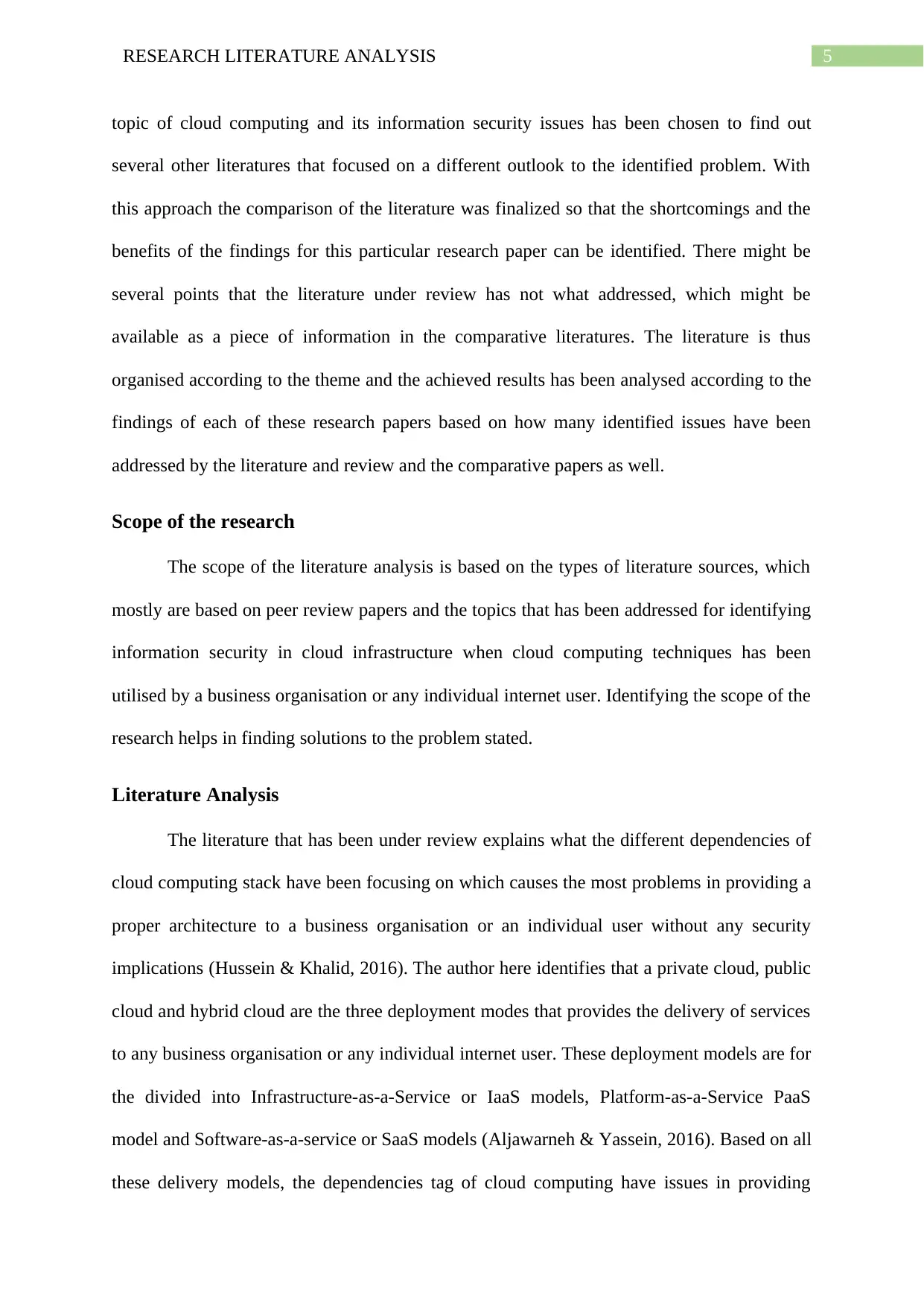
5RESEARCH LITERATURE ANALYSIS
topic of cloud computing and its information security issues has been chosen to find out
several other literatures that focused on a different outlook to the identified problem. With
this approach the comparison of the literature was finalized so that the shortcomings and the
benefits of the findings for this particular research paper can be identified. There might be
several points that the literature under review has not what addressed, which might be
available as a piece of information in the comparative literatures. The literature is thus
organised according to the theme and the achieved results has been analysed according to the
findings of each of these research papers based on how many identified issues have been
addressed by the literature and review and the comparative papers as well.
Scope of the research
The scope of the literature analysis is based on the types of literature sources, which
mostly are based on peer review papers and the topics that has been addressed for identifying
information security in cloud infrastructure when cloud computing techniques has been
utilised by a business organisation or any individual internet user. Identifying the scope of the
research helps in finding solutions to the problem stated.
Literature Analysis
The literature that has been under review explains what the different dependencies of
cloud computing stack have been focusing on which causes the most problems in providing a
proper architecture to a business organisation or an individual user without any security
implications (Hussein & Khalid, 2016). The author here identifies that a private cloud, public
cloud and hybrid cloud are the three deployment modes that provides the delivery of services
to any business organisation or any individual internet user. These deployment models are for
the divided into Infrastructure-as-a-Service or IaaS models, Platform-as-a-Service PaaS
model and Software-as-a-service or SaaS models (Aljawarneh & Yassein, 2016). Based on all
these delivery models, the dependencies tag of cloud computing have issues in providing
topic of cloud computing and its information security issues has been chosen to find out
several other literatures that focused on a different outlook to the identified problem. With
this approach the comparison of the literature was finalized so that the shortcomings and the
benefits of the findings for this particular research paper can be identified. There might be
several points that the literature under review has not what addressed, which might be
available as a piece of information in the comparative literatures. The literature is thus
organised according to the theme and the achieved results has been analysed according to the
findings of each of these research papers based on how many identified issues have been
addressed by the literature and review and the comparative papers as well.
Scope of the research
The scope of the literature analysis is based on the types of literature sources, which
mostly are based on peer review papers and the topics that has been addressed for identifying
information security in cloud infrastructure when cloud computing techniques has been
utilised by a business organisation or any individual internet user. Identifying the scope of the
research helps in finding solutions to the problem stated.
Literature Analysis
The literature that has been under review explains what the different dependencies of
cloud computing stack have been focusing on which causes the most problems in providing a
proper architecture to a business organisation or an individual user without any security
implications (Hussein & Khalid, 2016). The author here identifies that a private cloud, public
cloud and hybrid cloud are the three deployment modes that provides the delivery of services
to any business organisation or any individual internet user. These deployment models are for
the divided into Infrastructure-as-a-Service or IaaS models, Platform-as-a-Service PaaS
model and Software-as-a-service or SaaS models (Aljawarneh & Yassein, 2016). Based on all
these delivery models, the dependencies tag of cloud computing have issues in providing
⊘ This is a preview!⊘
Do you want full access?
Subscribe today to unlock all pages.

Trusted by 1+ million students worldwide
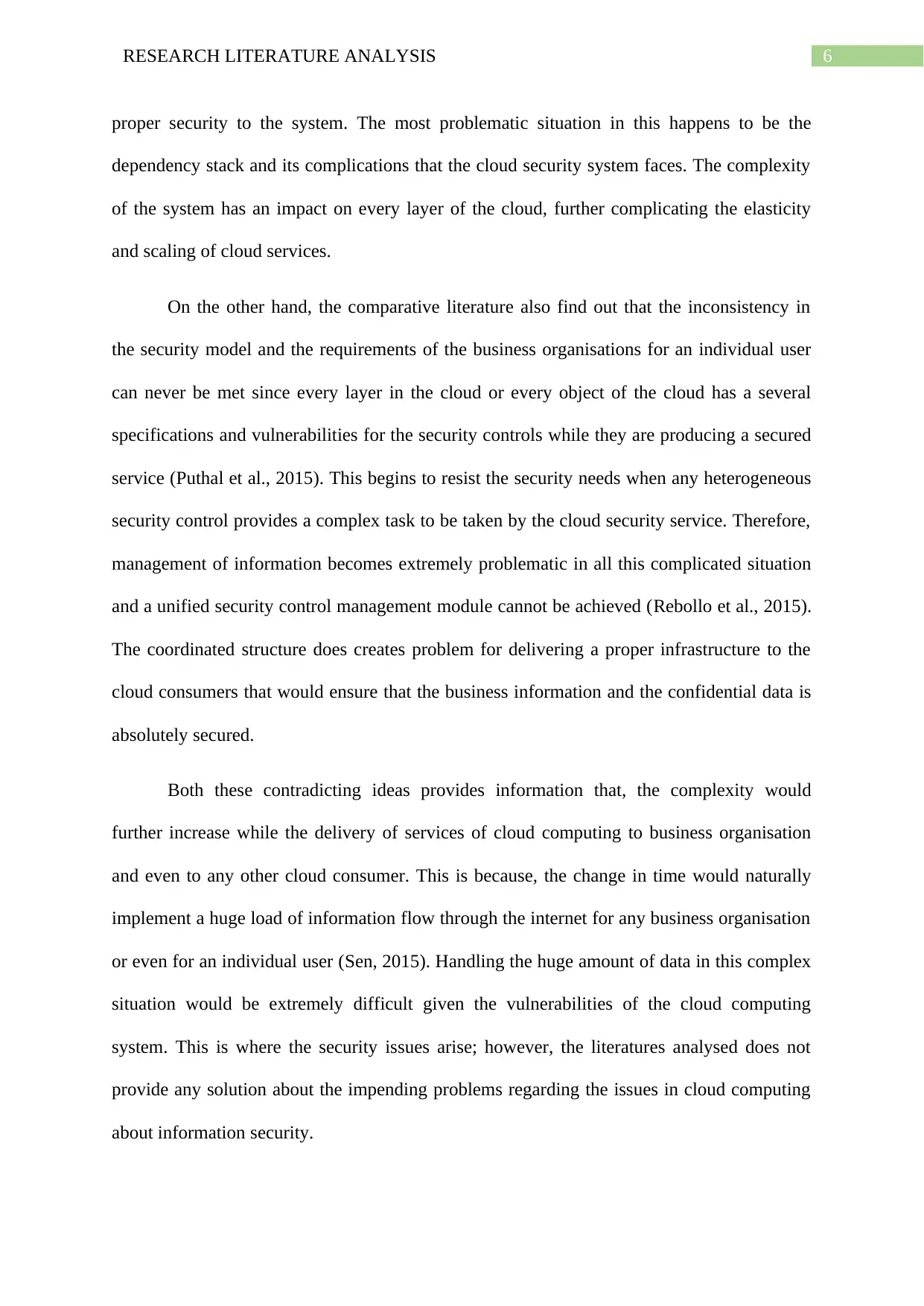
6RESEARCH LITERATURE ANALYSIS
proper security to the system. The most problematic situation in this happens to be the
dependency stack and its complications that the cloud security system faces. The complexity
of the system has an impact on every layer of the cloud, further complicating the elasticity
and scaling of cloud services.
On the other hand, the comparative literature also find out that the inconsistency in
the security model and the requirements of the business organisations for an individual user
can never be met since every layer in the cloud or every object of the cloud has a several
specifications and vulnerabilities for the security controls while they are producing a secured
service (Puthal et al., 2015). This begins to resist the security needs when any heterogeneous
security control provides a complex task to be taken by the cloud security service. Therefore,
management of information becomes extremely problematic in all this complicated situation
and a unified security control management module cannot be achieved (Rebollo et al., 2015).
The coordinated structure does creates problem for delivering a proper infrastructure to the
cloud consumers that would ensure that the business information and the confidential data is
absolutely secured.
Both these contradicting ideas provides information that, the complexity would
further increase while the delivery of services of cloud computing to business organisation
and even to any other cloud consumer. This is because, the change in time would naturally
implement a huge load of information flow through the internet for any business organisation
or even for an individual user (Sen, 2015). Handling the huge amount of data in this complex
situation would be extremely difficult given the vulnerabilities of the cloud computing
system. This is where the security issues arise; however, the literatures analysed does not
provide any solution about the impending problems regarding the issues in cloud computing
about information security.
proper security to the system. The most problematic situation in this happens to be the
dependency stack and its complications that the cloud security system faces. The complexity
of the system has an impact on every layer of the cloud, further complicating the elasticity
and scaling of cloud services.
On the other hand, the comparative literature also find out that the inconsistency in
the security model and the requirements of the business organisations for an individual user
can never be met since every layer in the cloud or every object of the cloud has a several
specifications and vulnerabilities for the security controls while they are producing a secured
service (Puthal et al., 2015). This begins to resist the security needs when any heterogeneous
security control provides a complex task to be taken by the cloud security service. Therefore,
management of information becomes extremely problematic in all this complicated situation
and a unified security control management module cannot be achieved (Rebollo et al., 2015).
The coordinated structure does creates problem for delivering a proper infrastructure to the
cloud consumers that would ensure that the business information and the confidential data is
absolutely secured.
Both these contradicting ideas provides information that, the complexity would
further increase while the delivery of services of cloud computing to business organisation
and even to any other cloud consumer. This is because, the change in time would naturally
implement a huge load of information flow through the internet for any business organisation
or even for an individual user (Sen, 2015). Handling the huge amount of data in this complex
situation would be extremely difficult given the vulnerabilities of the cloud computing
system. This is where the security issues arise; however, the literatures analysed does not
provide any solution about the impending problems regarding the issues in cloud computing
about information security.
Paraphrase This Document
Need a fresh take? Get an instant paraphrase of this document with our AI Paraphraser
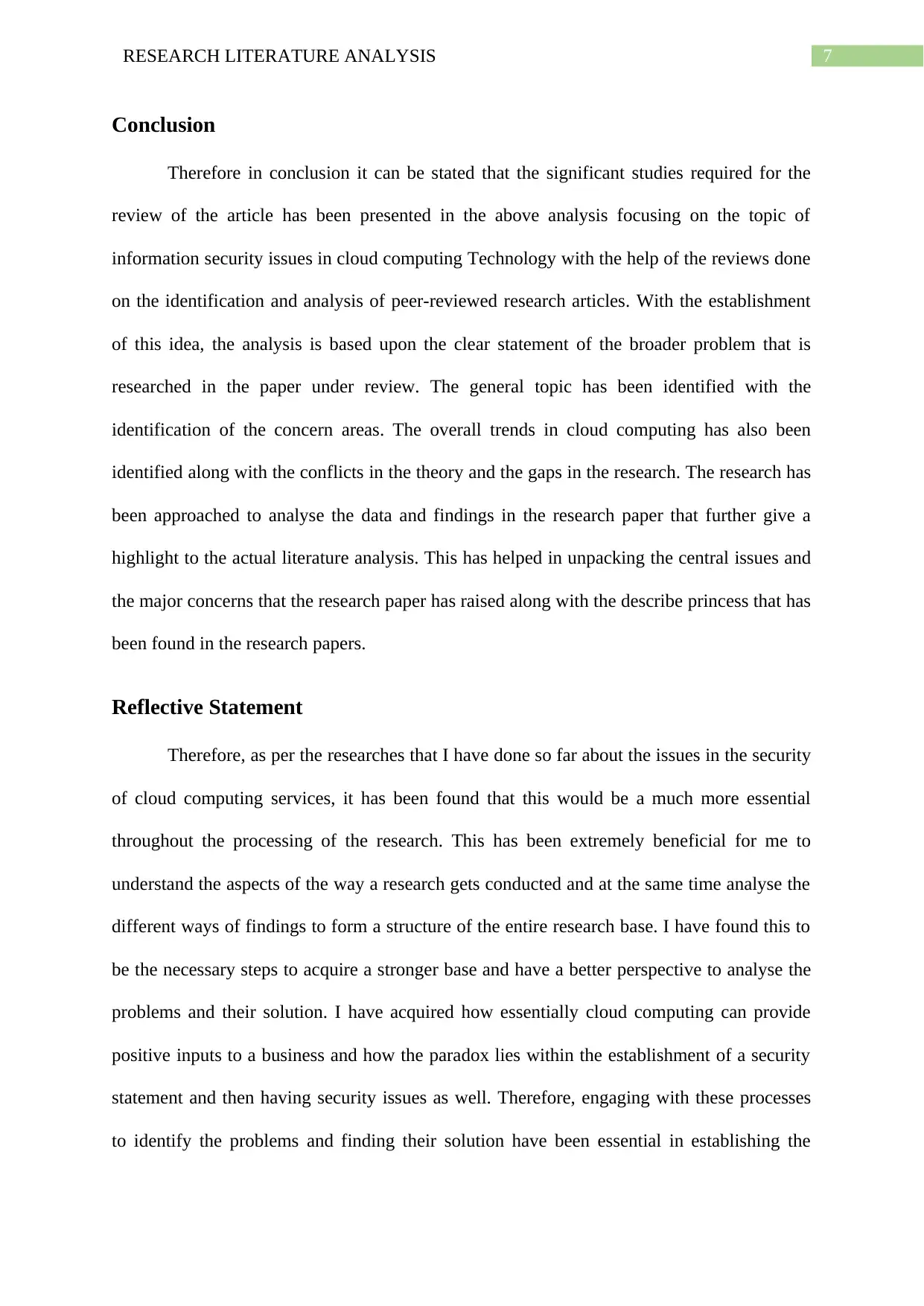
7RESEARCH LITERATURE ANALYSIS
Conclusion
Therefore in conclusion it can be stated that the significant studies required for the
review of the article has been presented in the above analysis focusing on the topic of
information security issues in cloud computing Technology with the help of the reviews done
on the identification and analysis of peer-reviewed research articles. With the establishment
of this idea, the analysis is based upon the clear statement of the broader problem that is
researched in the paper under review. The general topic has been identified with the
identification of the concern areas. The overall trends in cloud computing has also been
identified along with the conflicts in the theory and the gaps in the research. The research has
been approached to analyse the data and findings in the research paper that further give a
highlight to the actual literature analysis. This has helped in unpacking the central issues and
the major concerns that the research paper has raised along with the describe princess that has
been found in the research papers.
Reflective Statement
Therefore, as per the researches that I have done so far about the issues in the security
of cloud computing services, it has been found that this would be a much more essential
throughout the processing of the research. This has been extremely beneficial for me to
understand the aspects of the way a research gets conducted and at the same time analyse the
different ways of findings to form a structure of the entire research base. I have found this to
be the necessary steps to acquire a stronger base and have a better perspective to analyse the
problems and their solution. I have acquired how essentially cloud computing can provide
positive inputs to a business and how the paradox lies within the establishment of a security
statement and then having security issues as well. Therefore, engaging with these processes
to identify the problems and finding their solution have been essential in establishing the
Conclusion
Therefore in conclusion it can be stated that the significant studies required for the
review of the article has been presented in the above analysis focusing on the topic of
information security issues in cloud computing Technology with the help of the reviews done
on the identification and analysis of peer-reviewed research articles. With the establishment
of this idea, the analysis is based upon the clear statement of the broader problem that is
researched in the paper under review. The general topic has been identified with the
identification of the concern areas. The overall trends in cloud computing has also been
identified along with the conflicts in the theory and the gaps in the research. The research has
been approached to analyse the data and findings in the research paper that further give a
highlight to the actual literature analysis. This has helped in unpacking the central issues and
the major concerns that the research paper has raised along with the describe princess that has
been found in the research papers.
Reflective Statement
Therefore, as per the researches that I have done so far about the issues in the security
of cloud computing services, it has been found that this would be a much more essential
throughout the processing of the research. This has been extremely beneficial for me to
understand the aspects of the way a research gets conducted and at the same time analyse the
different ways of findings to form a structure of the entire research base. I have found this to
be the necessary steps to acquire a stronger base and have a better perspective to analyse the
problems and their solution. I have acquired how essentially cloud computing can provide
positive inputs to a business and how the paradox lies within the establishment of a security
statement and then having security issues as well. Therefore, engaging with these processes
to identify the problems and finding their solution have been essential in establishing the
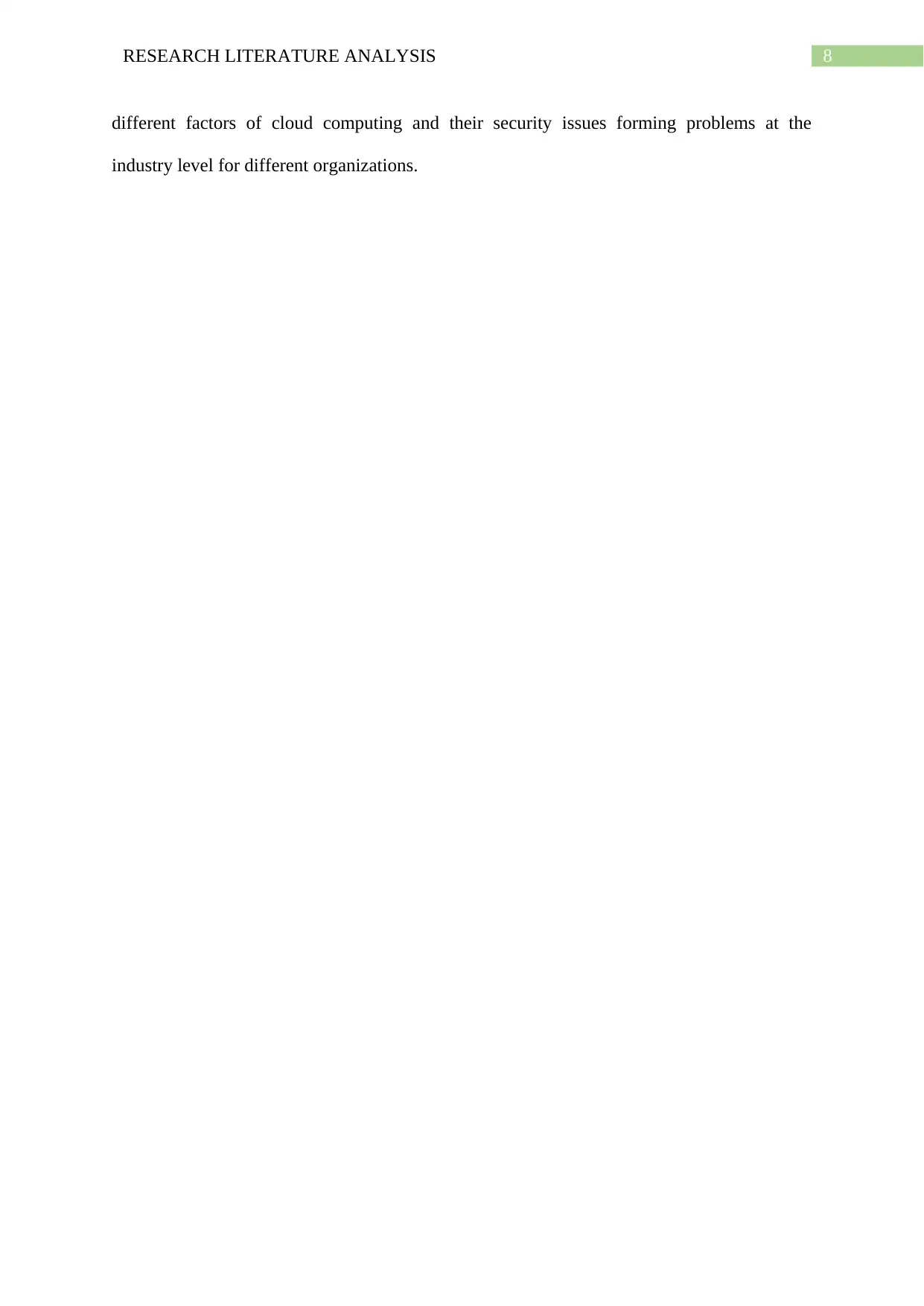
8RESEARCH LITERATURE ANALYSIS
different factors of cloud computing and their security issues forming problems at the
industry level for different organizations.
different factors of cloud computing and their security issues forming problems at the
industry level for different organizations.
⊘ This is a preview!⊘
Do you want full access?
Subscribe today to unlock all pages.

Trusted by 1+ million students worldwide
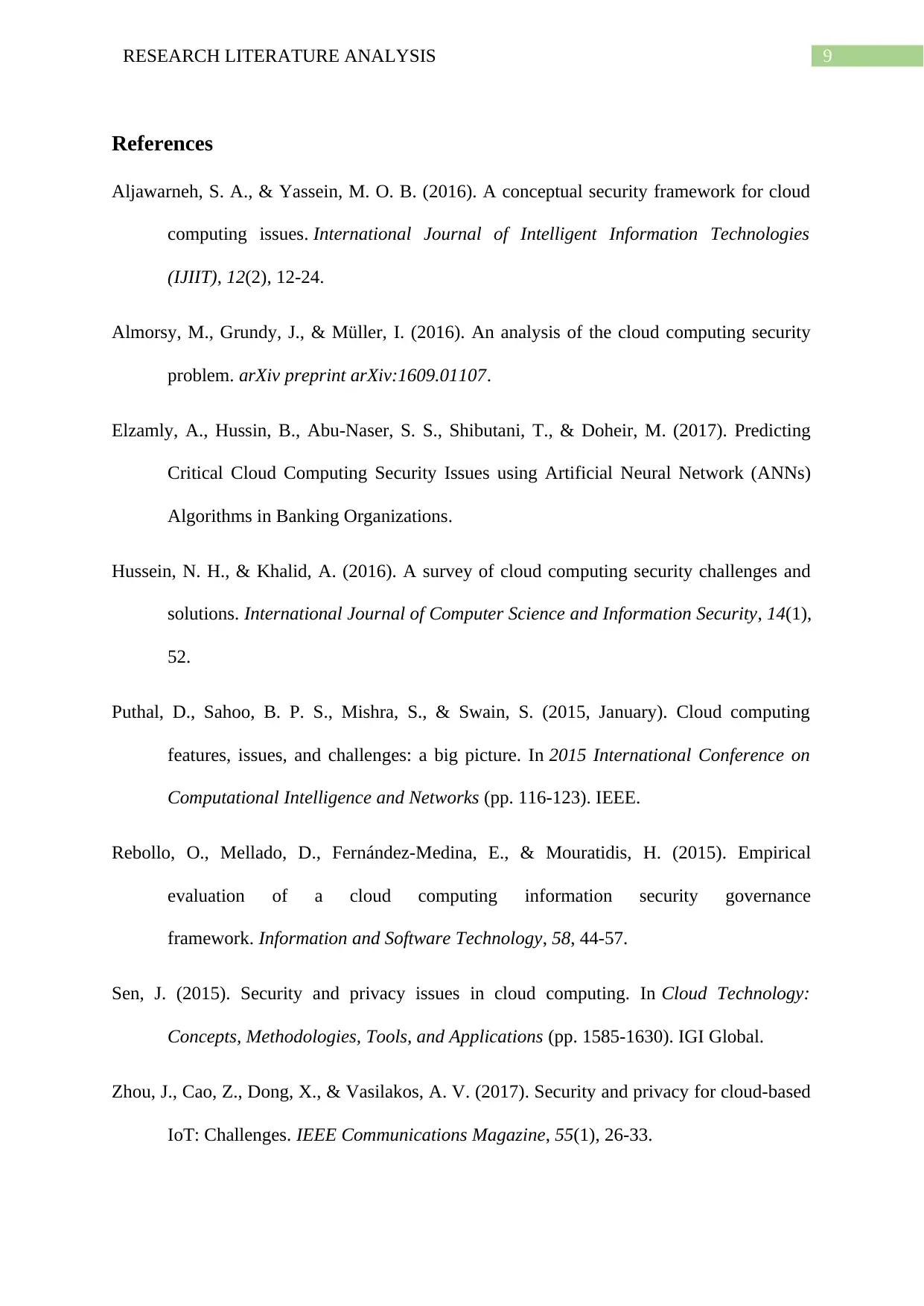
9RESEARCH LITERATURE ANALYSIS
References
Aljawarneh, S. A., & Yassein, M. O. B. (2016). A conceptual security framework for cloud
computing issues. International Journal of Intelligent Information Technologies
(IJIIT), 12(2), 12-24.
Almorsy, M., Grundy, J., & Müller, I. (2016). An analysis of the cloud computing security
problem. arXiv preprint arXiv:1609.01107.
Elzamly, A., Hussin, B., Abu-Naser, S. S., Shibutani, T., & Doheir, M. (2017). Predicting
Critical Cloud Computing Security Issues using Artificial Neural Network (ANNs)
Algorithms in Banking Organizations.
Hussein, N. H., & Khalid, A. (2016). A survey of cloud computing security challenges and
solutions. International Journal of Computer Science and Information Security, 14(1),
52.
Puthal, D., Sahoo, B. P. S., Mishra, S., & Swain, S. (2015, January). Cloud computing
features, issues, and challenges: a big picture. In 2015 International Conference on
Computational Intelligence and Networks (pp. 116-123). IEEE.
Rebollo, O., Mellado, D., Fernández-Medina, E., & Mouratidis, H. (2015). Empirical
evaluation of a cloud computing information security governance
framework. Information and Software Technology, 58, 44-57.
Sen, J. (2015). Security and privacy issues in cloud computing. In Cloud Technology:
Concepts, Methodologies, Tools, and Applications (pp. 1585-1630). IGI Global.
Zhou, J., Cao, Z., Dong, X., & Vasilakos, A. V. (2017). Security and privacy for cloud-based
IoT: Challenges. IEEE Communications Magazine, 55(1), 26-33.
References
Aljawarneh, S. A., & Yassein, M. O. B. (2016). A conceptual security framework for cloud
computing issues. International Journal of Intelligent Information Technologies
(IJIIT), 12(2), 12-24.
Almorsy, M., Grundy, J., & Müller, I. (2016). An analysis of the cloud computing security
problem. arXiv preprint arXiv:1609.01107.
Elzamly, A., Hussin, B., Abu-Naser, S. S., Shibutani, T., & Doheir, M. (2017). Predicting
Critical Cloud Computing Security Issues using Artificial Neural Network (ANNs)
Algorithms in Banking Organizations.
Hussein, N. H., & Khalid, A. (2016). A survey of cloud computing security challenges and
solutions. International Journal of Computer Science and Information Security, 14(1),
52.
Puthal, D., Sahoo, B. P. S., Mishra, S., & Swain, S. (2015, January). Cloud computing
features, issues, and challenges: a big picture. In 2015 International Conference on
Computational Intelligence and Networks (pp. 116-123). IEEE.
Rebollo, O., Mellado, D., Fernández-Medina, E., & Mouratidis, H. (2015). Empirical
evaluation of a cloud computing information security governance
framework. Information and Software Technology, 58, 44-57.
Sen, J. (2015). Security and privacy issues in cloud computing. In Cloud Technology:
Concepts, Methodologies, Tools, and Applications (pp. 1585-1630). IGI Global.
Zhou, J., Cao, Z., Dong, X., & Vasilakos, A. V. (2017). Security and privacy for cloud-based
IoT: Challenges. IEEE Communications Magazine, 55(1), 26-33.
1 out of 10
Related Documents
Your All-in-One AI-Powered Toolkit for Academic Success.
+13062052269
info@desklib.com
Available 24*7 on WhatsApp / Email
![[object Object]](/_next/static/media/star-bottom.7253800d.svg)
Unlock your academic potential
Copyright © 2020–2025 A2Z Services. All Rights Reserved. Developed and managed by ZUCOL.





